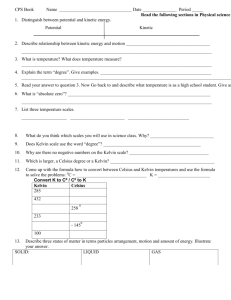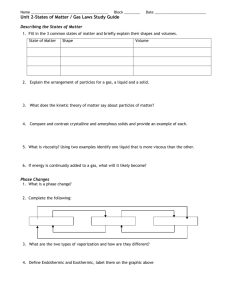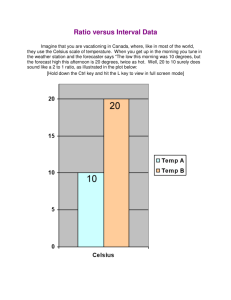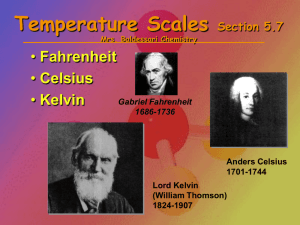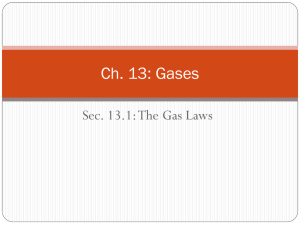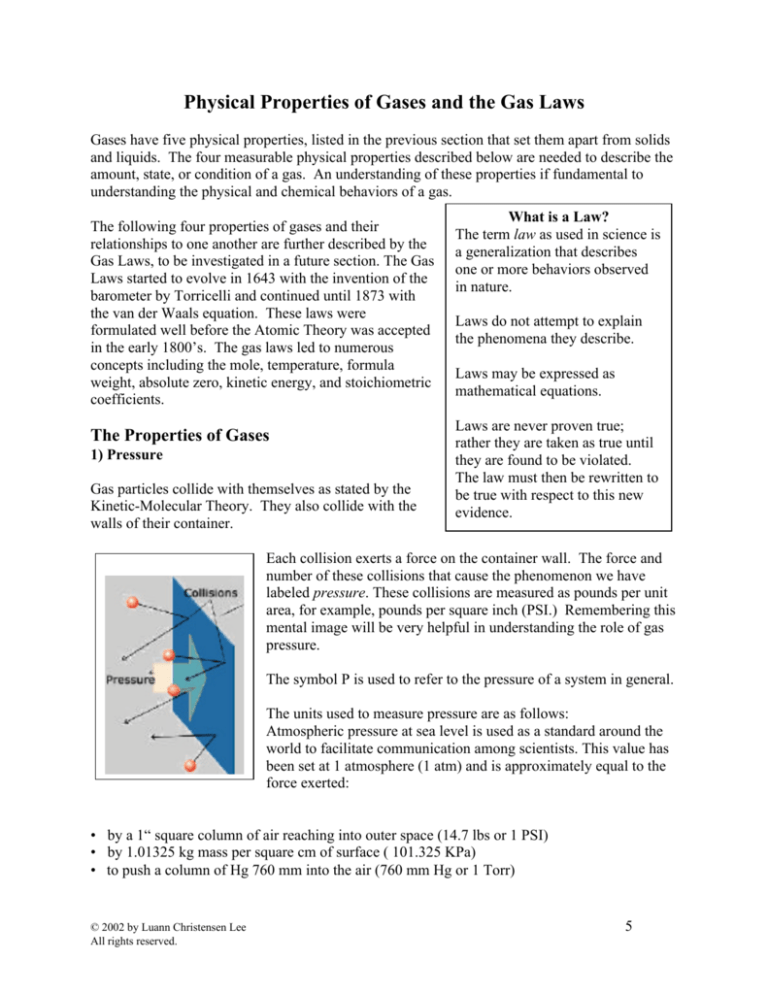
Physical Properties of Gases and the Gas Laws
Gases have five physical properties, listed in the previous section that set them apart from solids
and liquids. The four measurable physical properties described below are needed to describe the
amount, state, or condition of a gas. An understanding of these properties if fundamental to
understanding the physical and chemical behaviors of a gas.
The following four properties of gases and their
relationships to one another are further described by the
Gas Laws, to be investigated in a future section. The Gas
Laws started to evolve in 1643 with the invention of the
barometer by Torricelli and continued until 1873 with
the van der Waals equation. These laws were
formulated well before the Atomic Theory was accepted
in the early 1800’s. The gas laws led to numerous
concepts including the mole, temperature, formula
weight, absolute zero, kinetic energy, and stoichiometric
coefficients.
The Properties of Gases
1) Pressure
Gas particles collide with themselves as stated by the
Kinetic-Molecular Theory. They also collide with the
walls of their container.
What is a Law?
The term law as used in science is
a generalization that describes
one or more behaviors observed
in nature.
Laws do not attempt to explain
the phenomena they describe.
Laws may be expressed as
mathematical equations.
Laws are never proven true;
rather they are taken as true until
they are found to be violated.
The law must then be rewritten to
be true with respect to this new
evidence.
Each collision exerts a force on the container wall. The force and
number of these collisions that cause the phenomenon we have
labeled pressure. These collisions are measured as pounds per unit
area, for example, pounds per square inch (PSI.) Remembering this
mental image will be very helpful in understanding the role of gas
pressure.
The symbol P is used to refer to the pressure of a system in general.
The units used to measure pressure are as follows:
Atmospheric pressure at sea level is used as a standard around the
world to facilitate communication among scientists. This value has
been set at 1 atmosphere (1 atm) and is approximately equal to the
force exerted:
• by a 1“ square column of air reaching into outer space (14.7 lbs or 1 PSI)
• by 1.01325 kg mass per square cm of surface ( 101.325 KPa)
• to push a column of Hg 760 mm into the air (760 mm Hg or 1 Torr)
© 2002 by Luann Christensen Lee
All rights reserved.
5
Pressure Units and Conversions
The atmospheric pressure per square inch at sea level is
14.7 pounds of air per square inch of surface
14.7 pounds per square inch (PSI) is also equal to:
14.7 PSI = 1 atmosphere
14.7 PSI = 760 mm Hg (also known as 1 Torr)
14.7 PSI = 101.325 KPa
so:
1 atm = 760 mm Hg = 101.325 KPa
atmospheres (atm)
millimeters of mercury (mm Hg)
Pascals (Pa) or, more commonly, kiloPascals (KPa)
Standard pressure is defined as one atm. or 760.0 mm Hg or
101.325 KPa. Standard temperature, explained later, is taken at
0°C. Standard temperature and pressure are used commonly in
chemistry. The abbreviation is STP.
Figure 1:
A Simple Barometer: the air
is pressing down on the flat
surface of the mercury in
the dish with a force great
enough to cause the
mercury in the tube to rise
to a height of 760 mm.
There is no actual standard volume for gases. Gas volume varies greatly with temperature and
pressure. Volumes are sometimes described as Standard Molar Volume. Standard Molar
Volume will be defined in the next section as the volume occupied by one mole of any gas at the
standard pressure of 1 atm and the standard temperature of 0°Celsius.
2) Volume
The three-dimensional space enclosed by the container walls is called volume. The volume of a
gas is measured by placing it in a sealed container of known volume. The constant motion of the
particles of a gas as described earlier is responsible for the gas completely filling the container,
so the gas volume can be accurately taken as the volume of the container. When the generalized
variable of volume is discussed or used in an equation, the symbol V is used. The pressure and
temperature of the gas are needed to give meaning to the volume measurement as well.
Due to this movement of particles, the same number of particles in a sample of gas will fit any
container they are placed in. If the gas is allowed to flow into a larger container, the particles
will simply have more space to move and the
space between the particles increases. If the
Volume is measured in:
particles are forced into a smaller container, the
particles will have less space to move and the
Liters, represented by the unit L
space between them will decrease.
1 cubic decimeter (1 dm3) = 1 Liter.
milliliters , mL
Constant volume can be maintained if the
cubic feet, cu. ft. or ft3
container has thick, rigid walls as in a cylinder to
cubic centimeters, cc or cm
hold a compressed gas; for example a welder’s
tank or SCUBA cylinder.
© 2002 by Luann Christensen Lee
All rights reserved.
6
The units used must be consistent throughout the problem. Use the following common
conversions:
1 L = 1000 mL
1 mL = 1 cm3
Volume changes greatly in response to temperature and pressure changes. Boyle’s Law and
Charles’ Law illustrate these changes. Volume change means the container involved in the
experiment has a movable wall. The walls of the container move farther apart as the volume
increases. When the volume goes down, the walls move closer together again. There is no
movement of gas particles in or out of the container.
If the volume is constant, then the container is made with thick, rigid walls that cannot move. If
the pressure increases too much, the walls would break, destroying the experiment.
3. Temperature
Gas temperature is measured in degrees Celsius (°C). The word Celsius is capitalized, as it is the
surname of Anders Celsius. The symbol T is used to represent temperature in mathematical
equations.
The temperature scale important in describing gas behavior is called the Kelvin scale (K, with no
degree sign). Kelvin is capitalized because this was a person's title (Lord Kelvin, his given name
was William Thomson).
When collecting data on gases, temperatures are measured with a Celsius thermometer and
converted mathematically to Kelvin. Reasons why gas calculations must be done in Kelvins are
twofold:
1. The Kelvin temperature scale does not use negative numbers. 0 K is the lowest
temperature possible, Absolute Zero.
2. Charles’ Law shows the relationship between the changes in volume of a gas per
degree Celsius of temperature change to be 1/273 the volume of the gas per degree
Celsius temperature change. The Kelvin temperature scale is based on this
observation.
To convert between Celsius and Kelvin:
Kelvin = Celsius + 273.15.
Often, the value of 273 is used instead of 273.15. In either case, the number of significant digits
is taken to be the same as the temperature measurement used. All examples to follow will use
273 for convenience. For example, 25 °C = 298 K, because 25 + 273 = 298.
Standard temperature is defined as zero degrees Celsius or 273 K.
The Kelvin temperature of a gas is directly proportional to its kinetic energy. Double the Kelvin
temperature, you double the kinetic energy.
© 2002 by Luann Christensen Lee
All rights reserved.
7
4. Amount of Gas
The amount of gas present is measured in moles (mol) or in grams (g). Grams will need to be
converted to moles at some point. When the generalized variable of amount in moles is
discussed, the letter "n" is used as the symbol (note: the letter is in lowercase. The others above
are all caps.).
Standard Temperature and Pressure (STP)
Standard Temperature of a gas is 0°C or 273K. Standard pressure is 1 atm or 760 mm Hg.
Standard Molar Volume of a Gas
The volume of a gas is dependant on the temperature and pressure. If a fixed number of
particles, in this case 6.02 x 1023 particles, known collectively as 1 mole, are held at a constant
temperature of 1 atm (760 mm Hg) and 0°C (273K) they will occupy a volume of exactly 22.4
Liters.
This volume is the same regardless of what gas sample is used; be it O2 or N2 or CO2 or C3H8. If
1 mole of any gas is at STP, it will occupy a volume of 22.4 Liters. This is a convenient
relationship to know when working with gas laws and calculations.
Abbreviations
atm - atmosphere
mm Hg - millimeters of mercury
torr - another name for mm Hg
Pa - Pascal (kPa = kilo Pascal)
K - Kelvin
°C - degrees Celsius
© 2002 by Luann Christensen Lee
All rights reserved.
Conversions
K = °C + 273
1 cm3 (cubic centimeter) = 1 mL (milliliter)
1 dm3 (cubic decimeter) = 1 L (liter) = 1000 mL
Standard Conditions
0.00 °C = 273 K
1.00 atm = 760.0 mm Hg = 101.325 kPa = 101,325 Pa
8


![Temperature Notes [9/22/2015]](http://s3.studylib.net/store/data/006907012_1-3fc2d93efdacd086a05519765259a482-300x300.png)
